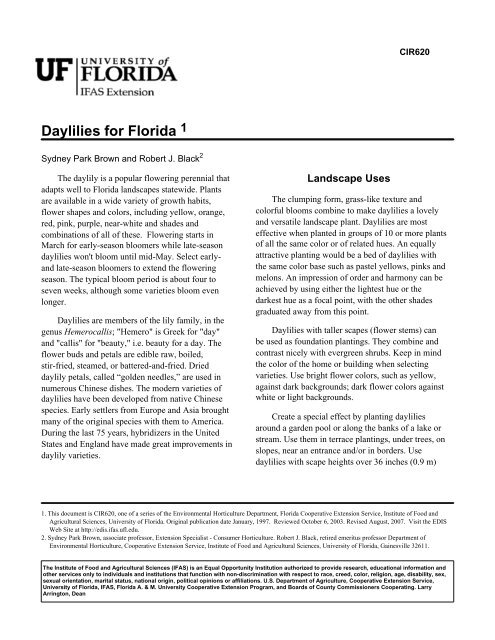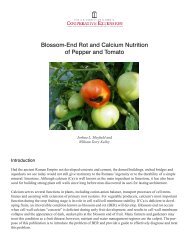Daylilies for Florida 1 - Your Southern Garden
Daylilies for Florida 1 - Your Southern Garden
Daylilies for Florida 1 - Your Southern Garden
Create successful ePaper yourself
Turn your PDF publications into a flip-book with our unique Google optimized e-Paper software.
CIR620<strong>Daylilies</strong> <strong>for</strong> <strong>Florida</strong> 1Sydney Park Brown and Robert J. Black 2The daylily is a popular flowering perennial thatadapts well to <strong>Florida</strong> landscapes statewide. Plantsare available in a wide variety of growth habits,flower shapes and colors, including yellow, orange,red, pink, purple, near-white and shades andcombinations of all of these. Flowering starts inMarch <strong>for</strong> early-season bloomers while late-seasondaylilies won't bloom until mid-May. Select earlyandlate-season bloomers to extend the floweringseason. The typical bloom period is about four toseven weeks, although some varieties bloom evenlonger.<strong>Daylilies</strong> are members of the lily family, in thegenus Hemerocallis; "Hemero" is Greek <strong>for</strong> "day"and "callis" <strong>for</strong> "beauty," i.e. beauty <strong>for</strong> a day. Theflower buds and petals are edible raw, boiled,stir-fried, steamed, or battered-and-fried. Drieddaylily petals, called “golden needles,” are used innumerous Chinese dishes. The modern varieties ofdaylilies have been developed from native Chinesespecies. Early settlers from Europe and Asia broughtmany of the original species with them to America.During the last 75 years, hybridizers in the UnitedStates and England have made great improvements indaylily varieties.Landscape UsesThe clumping <strong>for</strong>m, grass-like texture andcolorful blooms combine to make daylilies a lovelyand versatile landscape plant. <strong>Daylilies</strong> are mosteffective when planted in groups of 10 or more plantsof all the same color or of related hues. An equallyattractive planting would be a bed of daylilies withthe same color base such as pastel yellows, pinks andmelons. An impression of order and harmony can beachieved by using either the lightest hue or thedarkest hue as a focal point, with the other shadesgraduated away from this point.<strong>Daylilies</strong> with taller scapes (flower stems) canbe used as foundation plantings. They combine andcontrast nicely with evergreen shrubs. Keep in mindthe color of the home or building when selectingvarieties. Use bright flower colors, such as yellow,against dark backgrounds; dark flower colors againstwhite or light backgrounds.Create a special effect by planting dayliliesaround a garden pool or along the banks of a lake orstream. Use them in terrace plantings, under trees, onslopes, near an entrance and/or in borders. Usedaylilies with scape heights over 36 inches (0.9 m)1. This document is CIR620, one of a series of the Environmental Horticulture Department, <strong>Florida</strong> Cooperative Extension Service, Institute of Food andAgricultural Sciences, University of <strong>Florida</strong>. Original publication date January, 1997. Reviewed October 6, 2003. Revised August, 2007. Visit the EDISWeb Site at http://edis.ifas.ufl.edu.2. Sydney Park Brown, associate professor, Extension Specialist - Consumer Horticulture. Robert J. Black, retired emeritus professor Department ofEnvironmental Horticulture, Cooperative Extension Service, Institute of Food and Agricultural Sciences, University of <strong>Florida</strong>, Gainesville 32611.The Institute of Food and Agricultural Sciences (IFAS) is an Equal Opportunity Institution authorized to provide research, educational in<strong>for</strong>mation andother services only to individuals and institutions that function with non-discrimination with respect to race, creed, color, religion, age, disability, sex,sexual orientation, marital status, national origin, political opinions or affiliations. U.S. Department of Agriculture, Cooperative Extension Service,University of <strong>Florida</strong>, IFAS, <strong>Florida</strong> A. & M. University Cooperative Extension Program, and Boards of County Commissioners Cooperating. LarryArrington, Dean
<strong>Daylilies</strong> <strong>for</strong> <strong>Florida</strong> 2tall as foundation plantings, in the back of daylilybeds or mixed borders. Those 16 to 36 inches tall (0.4to 0.9 m), can be used in most settings. <strong>Daylilies</strong> withscapes 12 inches tall (0.3 m) or shorter, are best used<strong>for</strong> border plantings.SelectionLocal daylily societies and enthusiasts areusually happy to share in<strong>for</strong>mation about which typesgrow best in your area of the state. In<strong>for</strong>mation about<strong>Florida</strong> daylily societies can be found at:http://www.daylilies.org/AHSreg12.html<strong>Daylilies</strong> are usually available as potted plants orbare-root plants. Potted daylilies establish quickly andcan be found at garden centers <strong>for</strong> a reasonable price,although the choices are usually limited. The bestsources of daylilies are local daylily nurseries, whichsell bare-root plants at the site, by mail-order oron-line. Local nurseries typically carry the bestper<strong>for</strong>mers <strong>for</strong> their regions as well as the latestvarieties. Price may range from economical to veryexpensive.When selecting a daylily, remember that thereare three types of foliage growth:• Dormant - The foliage dies back after frost andnew foliage grows in the spring. In central andsouth <strong>Florida</strong>, these types may not receivesufficient winter “chilling” to grow and bloomsuccessfully.• Evergreen - The foliage remains greenthroughout the year.• Semi-Evergreen -Today, the termsemi-evergreen describes a plant whose foliagecan be either evergreen or dormant depending onwhere the plant is grown.Daylily flowers vary in size from a few inches upto 10 inches. Most are about 5-6 inches across. Manycolor patterns are now available ranging from purecolors to blends of two, three or more colors. Sometypes have petals and sepals of different colors.Others have colored throats, or contrasting midribs oredges.Daylily blooms are also available in a widevariety of shapes and <strong>for</strong>ms from the simplest single(3 petals and 3 sepals) to double, spider and highlyunusual shapes that twist, curl or cascade. For detailedin<strong>for</strong>mation, visit:http://www.daylilies.org/ahs_dictionary/flower_<strong>for</strong>ms.htmlPlanting SiteIn <strong>Florida</strong>, the daylily is considered acosmopolitan plant that thrives in the muck of theEverglades, the limestone rock of Dade County, thelight sands of central <strong>Florida</strong> and the red clay of thenorthern part of the state. While daylilies will growunder many conditions, select the most favorablelocation <strong>for</strong> the best results.<strong>Daylilies</strong> grow in full sun or filtered shade. Thedarker colored varieties (reds and purples) grow bestin partial shade, while light colored varieties(yellows, pinks and pastels) need full sun to bring outtheir lovely colors. Heavy shade should be avoidedbecause it will cause thin, spindly growth and poorflowering. The light level under pine trees is ideal <strong>for</strong>growing daylilies.Amend the soil <strong>for</strong> a daylily bed with 3 to 4inches of organic matter, such as peat, compost orwell-rotted manure. A fertilizer as close as you canfind to a N:P:K ratio of 3:1:2 is recommended versusa “balanced” ratio (1:1:1). Add 3/4 to 1-1/2 poundsper 100 square feet of bed. The amended soil shouldbe mixed or tilled, leveled and moistened. The soilpH should be between 6.2 – 6.8 with 6.5 beingoptimal. <strong>Your</strong> county Extension office can providein<strong>for</strong>mation about soil testing:http://solutions<strong>for</strong>yourlife.ufl.edu/map/Planting<strong>Daylilies</strong> can be planted throughout the year in<strong>Florida</strong>; however, spring and fall are ideal. Fallplanting allows the plants time to develop new rootsand become established be<strong>for</strong>e the next bloomingseason. Prepare bare-root daylilies <strong>for</strong> planting byremoving foliage 6 to 8 inches (15.2 to 20.3 cm)from the crown, the point where foliage and roots joinand trimming in an inverted V-shape. Examine the
<strong>Daylilies</strong> <strong>for</strong> <strong>Florida</strong> 3root system closely and remove any damaged roots.Potted daylilies do not require this preparation.Plant daylilies 18 to 24 inches (0.5 to 0.6 m)apart, since some varieties multiply quickly andbecome so crowded that flower production isaffected. When spaced this way, daylilies will usuallynot need to be divided <strong>for</strong> 3 to 5 years.To plant a bare-root daylily, dig a hole larger thanthe root mass with a trowel or small shovel. Make amound of soil in the center of the hole and set thecenter of the daylily on top of the mound, spreadingroots out to the sides of the mound (Figure 1). Next,fill in the hole with loose soil, making sure the crownof the daylily is at ground level. Plant bare-root andpotted daylilies at the same depth at which they wereoriginally grown. Water well, mulch and keep the soilmoist until plants are well established.Figure 1. Proper planting of daylily.General CareMulch daylilies to help retain soil moisture,reduce weeds and moderate soil temperatures. Pineneedles, leaves or shredded pine bark are among themost desirable mulches and should be applied in a 2-to 3-inch (5.1 cm) layer.<strong>Daylilies</strong> survive dry conditions well due to theirextensive root systems. However, the number andsize of blooms, plant growth and overall vigor can beadversely affected by prolonged drought. Aspectacular display of blooms can be achieved by theweekly application of 1/2- 2 inches of irrigation orrain. During the summer heat, irrigate themfrequently if regular rainfall does not occur. The besttime to water is in the early evening because theplants benefit from moist soil during the eveninghours. Fertilize daylilies in the fall, early spring andmid-summer with 3/4 to 1-1/2 pounds of fertilizer per100 square feet of bed. Use the same general N:P:Kratio fertilizer used at planting time. Fertilizer shouldbe evenly applied between plants, kept off the foliageand watered into the soil after application.Insects, Mites and Diseases<strong>Daylilies</strong> are rarely bothered by pests, however,aphids, thrips, spider mites and grasshoppers areknown to occasionally attack the foliage and flowerbuds. Aphids are small, soft-bodied insects withsucking mouthparts. They feed on leaves, causing thetips of the damaged leaves to curl and die.Most home gardeners do not realize spider mitesare present until damage is severe. These pests arevery tiny and usually go undetected on the undersidesof leaves. Mites damage leaves by sucking plantjuices and chlorophyll. Damaged leaves lose theirgreen color, turn tan and then brown, and eventuallydie.Thrips are one of the most serious pests thatattack daylilies. Thrips are gray-black insects aboutthe size and shape of the upper part of a smallexclamation point (!). Thrips damage immaturestems and blooms. The damage causes discolored,misshapen flowers and reduces flower bud set.Grasshoppers chew the leaves and their damage iseasy to detect.In 2000, a newly introduced airborne fungus –Puccinia hemerocallis - called daylily rust began toattack daylilies nationwide. It will not kill anotherwise healthy plant but will make it quiteunsightly and decrease its per<strong>for</strong>mance. The mostobvious symptoms of daylily rust are yellow tobrown streaks and small, very bright yellow spots onthe surfaces of the leaves. Small, orange to yellowspots on the undersurfaces of the leaves containpustules that release numerous dust-like,orange-colored spores. As symptoms progress, leavesturn yellow and dry.Management strategies <strong>for</strong> daylily rust includegrowing varieties that are resistant to this disease,cutting off infected foliage and removing it from thegarden, and periodically spraying susceptible plantswith fungicides. Local daylily societies can providein<strong>for</strong>mation on rust-resistant cultivars and other
<strong>Daylilies</strong> <strong>for</strong> <strong>Florida</strong> 4localized in<strong>for</strong>mation about daylilies in general. Atthis time there is not a published or on-line list ofrust-resistant varieties.Apply a pesticide only when insect, mite ordisease infestations are severe or when large numbersof plants are affected. For recommendations onselection and application of pesticides, contact yourcounty's Extension office:http://solutions<strong>for</strong>yourlife.ufl.edu/map/.Propagation and Hybridizing<strong>Daylilies</strong> are propagated by seed, division or byproliferations (small plants that grow on the flowerstalk). Although daylilies can be grown readily fromseed, genetic variation in seedling populations isgreat. There<strong>for</strong>e, named varieties and selected clonesmust be propagated vegetatively (by division orproliferations) to maintain a true line.The flower stems or scapes of daylilies oftendevelop small plants called proliferations that can beremoved and rooted to <strong>for</strong>m another plant. Cut thescape a few inches below the proliferation and placeit into a potting mix so that the base of theproliferation is in contact with the soil. Keep the plantwatered while it is establishing its root system.Breeding daylilies can be an enjoyable andrewarding experience. The large flowers are easy towork with (Figure 3) and the male and femalereproductive parts are easy to see. Hybridizing isusually done to improve plant characteristics such asflower color, width of petals, number of blooms andlength of scapes. Carefully study each plant'sdesirable features and never cross daylilies that haveserious weaknesses.<strong>Daylilies</strong> multiply fairly rapidly and plantdivision is an easy way to propagate them. (Figure2). Division is best done immediately after theflowering season. Dig the entire clump and shake orwash off the soil without damaging the roots. Itshould be fairly easy to see how many divisions canbe made. Next, cut the leaves off 6 inches (15.2 cm)above the crown and divide the clump with a sharpknife. Smaller clumps can be pulled apart. The oldportions of the roots should be pruned to promote the<strong>for</strong>mation of new roots. After the plant is divided, itis ready to be planted as described above.Figure 3. Parts of daylily.There are 2 types of daylilies, diploids (2 sets ofchromosomes) and tetraploids (4 sets) and the twocannot be crossed successfully. It is difficult <strong>for</strong> thelayperson to tell them apart, but you can consult theDaylily Registry, a database maintained by theAmerican Hemerocallis Society, <strong>for</strong> that in<strong>for</strong>mation:http://www.daylilydatabase.org/. If the cultivarnames are unknown, make several crosses withdifferent plants and see which set seed.Figure 2. Division of parent clump.In Figure 3, you can see six stamens (malereproductive parts) and 1 pistil (female reproductive
<strong>Daylilies</strong> <strong>for</strong> <strong>Florida</strong> 5part). The yellow, powdery pollen is held on the tipsof the stamens. It is a simple procedure to take pollenfrom one flower and place it on the pistil of anotherflower. First remove the anthers of the female parentto prevent accidental self-fertilization. Then break offa stamen from the male parent and rub thepollen-laden end across the sticky tip of the pistil ofthe female parent. A small paint brush can also beused to transfer pollen.Crosses should be labeled, listing both parentsand date of pollination. The pods will ripen in six toeight weeks and are ready <strong>for</strong> collection when theyturn brown, begin to dry and the tops start to split.Plant freshly harvested seed in flats or pots filledwith commercial potting soil. Cover the seeds withfinely sifted soil to a depth of 1/8 to 1/4 inch (3.2 to6.4 cm). Keep the soil carefully watered and moistwhile seeds are germinating. Place the flats or pots ina shaded location and cover with glass or clear plasticto prevent the soil from drying out. Seeds of dayliliesgerminate in 10 days to 2 weeks and require nospecial treatment. When seedlings are 4-6 inches(10.2 cm) in height, transplant them into new flats orpots, spacing them 1 to 2 inches (2.5 to 5.1 cm) apart.Some prefer to leave the seedlings in flats until theyare large enough to set out in the landscape. <strong>Daylilies</strong>usually take 2 years from seed to flowering.However, if seeds are harvested in May andimmediately germinated and if seedlings are givengood care, it is possible in <strong>Florida</strong> to have a seedlingbloom by the following year.ReferencesCornell University Fact Sheet. Daylily Rust -Puccinia hemerocallidis.http://plantclinic.cornell.edu/FactSheets/daylily%20rust/daylilyrust.htmThe American Hemerocallis Society.http://www.daylilies.org/






